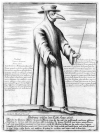Biological and Psychological Factors Determining Neuropsychiatric Outcomes in COVID-19
- PMID: 34648081
- PMCID: PMC8485771
- DOI: 10.1007/s11920-021-01275-3
Biological and Psychological Factors Determining Neuropsychiatric Outcomes in COVID-19
Abstract
Purpose of review: We present biological and psychological factors implicated in psychiatric manifestations of SARS-CoV-2, as well as its neuroinvasive capability and immune pathophysiology.
Recent findings: Preexisting mental illness leads to worse clinical outcomes in COVID-19. The presence of the virus was reported in the cerebrospinal fluid (CSF) and brain tissue post-mortem. Most common psychiatric manifestations include delirium, mood disorders, anxiety disorders, and posttraumatic stress disorder. "Long-COVID" non-syndromal presentations include "brain-fogginess," autonomic instability, fatigue, and insomnia. SARS-CoV-2 infection can trigger prior vulnerabilities based on the priming of microglia and other cells, induced or perpetuated by aging and mental and physical illnesses. COVID-19 could further induce priming of neuroimmunological substrates leading to exacerbated immune response and autoimmunity targeting structures in the central nervous system (CNS), in response to minor immune activating environmental exposures, including stress, minor infections, allergens, pollutants, and traumatic brain injury.
Keywords: COVID-19; Neuroinflammation; Neuroinvasion; Neuropsychiatric; Priming; SARS-CoV-2.
© 2021. This is a U.S. government work and not under copyright protection in the U.S.; foreign copyright protection may apply.
Conflict of interest statement
Dr. Christopher A. Lowry serves on the Scientific Advisory Board of Immodulon Therapeutics, Ltd., is Co-founder and Chief Scientific Officer of Mycobacteria Therapeutics Corporation, serves as an unpaid scientific consultant to Aurum Switzerland AG, and is a member of the faculty of the Integrative Psychiatry Institute. In the past 3 years, Dr. Kessler was a consultant for Datastat, Inc., Holmusk, RallyPoint Networks, Inc., and Sage Therapeutics. Dr. Kessler also has stock options in Mirah, PYM, and Roga Sciences. All other authors did not declare any conflict of interest.
Figures


Similar articles
-
[Neuropsychiatric Aspects of COVID-19 - A Narrative Overview].Fortschr Neurol Psychiatr. 2022 Mar;90(3):108-120. doi: 10.1055/a-1523-3850. Epub 2021 Aug 2. Fortschr Neurol Psychiatr. 2022. PMID: 34341978 Review. German.
-
The impact of COVID-19 on diagnostic biomarkers in neuropsychiatric and neuroimmunological diseases: a review.Rev Neurosci. 2021 Jun 7;33(1):79-92. doi: 10.1515/revneuro-2020-0154. Print 2022 Jan 27. Rev Neurosci. 2021. PMID: 34087964 Review.
-
Editorial: The Pathogenesis of Long-Term Neuropsychiatric COVID-19 and the Role of Microglia, Mitochondria, and Persistent Neuroinflammation: A Hypothesis.Med Sci Monit. 2021 May 10;27:e933015. doi: 10.12659/MSM.933015. Med Sci Monit. 2021. PMID: 34016942 Free PMC article.
-
[Interaction of somatic findings and psychiatric symptoms in COVID-19. A scoping review].Neuropsychiatr. 2024 Mar;38(1):1-23. doi: 10.1007/s40211-023-00487-8. Epub 2023 Dec 6. Neuropsychiatr. 2024. PMID: 38055146 German.
-
Role of neuroinflammation mediated potential alterations in adult neurogenesis as a factor for neuropsychiatric symptoms in Post-Acute COVID-19 syndrome-A narrative review.PeerJ. 2022 Nov 4;10:e14227. doi: 10.7717/peerj.14227. eCollection 2022. PeerJ. 2022. PMID: 36353605 Free PMC article. Review.
Cited by
-
The COVID-19 pandemic, an environmental neurology perspective.Rev Neurol (Paris). 2022 Jun;178(6):499-511. doi: 10.1016/j.neurol.2022.02.455. Epub 2022 Mar 22. Rev Neurol (Paris). 2022. PMID: 35568518 Free PMC article. Review.
-
Neuroinflammation in Dementia-Therapeutic Directions in a COVID-19 Pandemic Setting.Cells. 2022 Sep 22;11(19):2959. doi: 10.3390/cells11192959. Cells. 2022. PMID: 36230921 Free PMC article. Review.
-
Effects of COVID-19 Infection and Vaccination on the Female Reproductive System: A Narrative Review.Balkan Med J. 2023 May 8;40(3):153-164. doi: 10.4274/balkanmedj.galenos.2023.2023-3-4. Epub 2023 Apr 28. Balkan Med J. 2023. PMID: 37114907 Free PMC article. Review.
-
Greater fatigue is more strongly associated with reduced reward sensitivity in the long-term phase of coronavirus disease (COVID-19) than in the early phase.Brain Behav Immun Health. 2025 Jul 5;48:101056. doi: 10.1016/j.bbih.2025.101056. eCollection 2025 Oct. Brain Behav Immun Health. 2025. PMID: 40686929 Free PMC article.
-
Aged brain and neuroimmune responses to COVID-19: post-acute sequelae and modulatory effects of behavioral and nutritional interventions.Immun Ageing. 2023 Apr 12;20(1):17. doi: 10.1186/s12979-023-00341-z. Immun Ageing. 2023. PMID: 37046272 Free PMC article. Review.
References
-
- •• Najjar S, Najjar A, Chong DJ, Pramanik BK, Kirsch C, Kuzniecky RI, et al. Central nervous system complications associated with SARS-CoV-2 infection: integrative concepts of pathophysiology and case reports. J Neuroinflammation. 2020;17(1):231. 10.1186/s12974-020-01896-0. Details how the monocytes and macrophages are manipulated to serve the aims of transportation of the virus and its panorgan invasion. - PMC - PubMed
Papers of particular interest, published recently, have been highlighted as: • Of importance •• Of major importance
-
- National Center for Health Statistics (NCHS), Census Bureau. Mental Health - Household Pulse Survey - COVID-19. 2020. https://www.cdc.gov/nchs/covid19/pulse/mental-health.htm. Accessed November 27, 2020.
-
- Malik YA. Properties of coronavirus and SARS-CoV-2. Malays J Pathol. 2020;42(1):3–11. - PubMed
-
- Wang K, Chen W, Zhou Y-S, Lian J-Q, Zhang Z, Du P, et al. SARS-CoV-2 invades host cells via a novel route: CD147-spike protein. bioRxiv. 2020:2020.03.14.988345. 10.1101/2020.03.14.988345.
Publication types
MeSH terms
LinkOut - more resources
Full Text Sources
Medical
Research Materials
Miscellaneous

